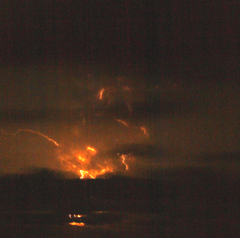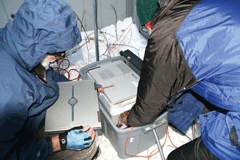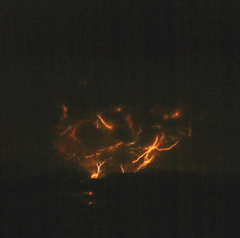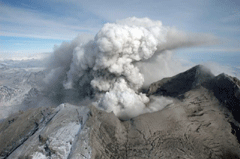Volcanic Lightning
Air Date: Week of April 24, 2009

Mount Redoubt lightning. (Credit: Bretwood Higman)
Scientists have long been puzzled as to why when volcanoes erupt, they’re often accompanied by lightning. When Alaska’s Mount Redoubt began rumbling, researchers quickly moved to install sensors to track radio signals created by lightning flashes. As Spectrum Radio’s Prachi Patel reports, they’ve been surprised by some of the results.
Transcript
YOUNG: Vesuvius, Krakatoa, Mt. Saint Helens - these volcanoes have caused massive devastation. And they have one more thing in common - their eruptions produced stunning displays of lightning. No one understands exactly why – so a team of researchers in New Mexico has been investigating.
And as Spectrum’s Prachi Patel discovered, the eruption of Alaska’s Mount Redoubt in late March was just the chance they’d been waiting for.
PATEL: Mount Redoubt rises over ten thousand feet in Lake Clark National Park, some 100 miles southwest of Anchorage. It began rumbling in January. But Steve McNutt, a scientist at the Alaska Volcano Observatory, had his eyes on Redoubt since November 2008, when it first started spitting heat and gas.

New Mexico Tech Professors Ronald Thomas (R) and Paul Krehbiel set up lightning sensors in Kenai, Alaska across Cook Inlet from Mt. Redoubt.
(Sonja Behnke/New Mexico Tech)
PATEL: Those four instruments are lightning sensors. Researchers at the New Mexico Institute of Mining and Technology developed them in 1997 to study thunderstorm lightning. Three years ago, they switched gears, packed the sensors in modified picnic coolers and set off to stalk volcanoes.
Redoubt is the third one they’ve studied. But it’s the very first time they had the instruments installed before a volcano blew its top. The sensors pick up radio frequency signals created by flashes of lightning.

Mount Redoubt lightning. (Bretwood Higman)
[SOUND OF POPPING RADIO IMPULSES]
PATEL: These radio signal recorded during the Mount Redoubt eruption let the researchers peek inside a volcano’s ash cloud. To do that, the sensor stations have to be set up at different distances from the volcano. Ronald Thomas is an electrical engineering and atmospheric physics professor at New Mexico Tech.
THOMAS: The lightning signals arrive at the closest station first and then the next closest station after that and so on arriving at the farthest station last. And then by putting that back together you can tell where the lighting came from.
PATEL: That is, you can locate exactly where the electrical discharge happened inside the volcano’s ash cloud.
THOMAS: And that way it gives us a nice picture of the lightning. Actually there’s thousands of impulses from each lightning so we get a whole just like a photograph of the lightning except it’s inside the cloud.

Mount Redoubt lightning. (Bretwood Higman)
PATEL: The three-dimensional picture shows where the electrical charges are in the cloud. And that, Thomas hopes, might reveal why some eruptions have a charge in the first place.
The findings could answer a few questions about how life started on earth. Some scientists believe that volcanic lightning might’ve been the true spark of life, converting a soup of water, ammonia, and methane into the building blocks of proteins. But the researchers’ work isn’t just about scientific curiosity. Their hope is that the lightning sensors could lead to an early warning system for eruptions.
At the National Severe Storms Laboratory in Norman, Oklahoma, researchers are studying thunderstorm lightning. Don MacGorman is a physicist at the laboratory.
MACGORMAN: We’re trying to understand how we can use lightning data to help us forecast and warn of weather hazards more accurately and in a more timely way.
PATEL: MacGorman uses the sensor system that the New Mexico researchers made. He’s been using it since 1998. He says the surprises come often.
MACGORMAN: We’re seeing things that we never suspected were occurring in a thunderstorm. We’re seeing for example that the very tip-tops of some very severe storms, the part of the cloud that goes up above into the stratosphere actually does have some little lightning flashes for want of a better word but they’re little sparks it looks like.

Mt. Redoubt erupts! (Game McGimsey, Alaska Volcano Observatory/USGS)
PATEL: NASA and the National Weather Service also use the sensors to track storm lightning. But the New Mexican researchers are the only ones studying lightning at volcanoes. Until they started doing that, scientists had thought the two types of lightning were similar. Just as charge created inside a storm cloud triggers lightning, charge created in a volcano’s ash cloud was thought to create flashes. But researcher Ronald Thomas says there might be more to volcanoes.
THOMAS: In the volcanic eruption we see lightning almost immediately as it starts to erupt and that tells us that the particles are coming out of the volcano charged.
PATEL: That’s not what Thomas was expecting.
THOMAS: The lightning we see just as the volcano erupts almost certainly has to be formed inside the volcano.
PATEL: Thomas doesn’t know why this happens, but he says they hope to find out at Redoubt. The volcano began erupting in March and has been generous.
THOMAS: So far we’ve gotten over 20 eruptions with lightning with all the big eruptions, in all the big eruptions. We’re just getting lots and lots of data and a lot more than we expected or lot more than we’d hoped for. It’s really amazing.
PATEL: The explosion of research riches is likely to keep them busy for months and perhaps years to come. For Living on Earth, I’m Prachi Patel.
YOUNG: Our report on volcanic lightning comes to us courtesy of Spectrum Radio, the broadcast edition of IEEE Spectrum, the magazine of technology insiders.
Links
Living on Earth wants to hear from you!
Living on Earth
62 Calef Highway, Suite 212
Lee, NH 03861
Telephone: 617-287-4121
E-mail: comments@loe.org
Newsletter [Click here]
Donate to Living on Earth!
Living on Earth is an independent media program and relies entirely on contributions from listeners and institutions supporting public service. Please donate now to preserve an independent environmental voice.
NewsletterLiving on Earth offers a weekly delivery of the show's rundown to your mailbox. Sign up for our newsletter today!
 Sailors For The Sea: Be the change you want to sea.
Sailors For The Sea: Be the change you want to sea.
 The Grantham Foundation for the Protection of the Environment: Committed to protecting and improving the health of the global environment.
The Grantham Foundation for the Protection of the Environment: Committed to protecting and improving the health of the global environment.
 Contribute to Living on Earth and receive, as our gift to you, an archival print of one of Mark Seth Lender's extraordinary wildlife photographs. Follow the link to see Mark's current collection of photographs.
Contribute to Living on Earth and receive, as our gift to you, an archival print of one of Mark Seth Lender's extraordinary wildlife photographs. Follow the link to see Mark's current collection of photographs.
 Buy a signed copy of Mark Seth Lender's book Smeagull the Seagull & support Living on Earth
Buy a signed copy of Mark Seth Lender's book Smeagull the Seagull & support Living on Earth

